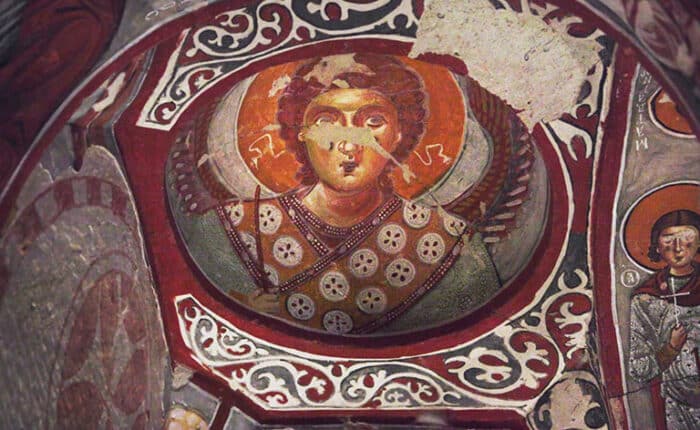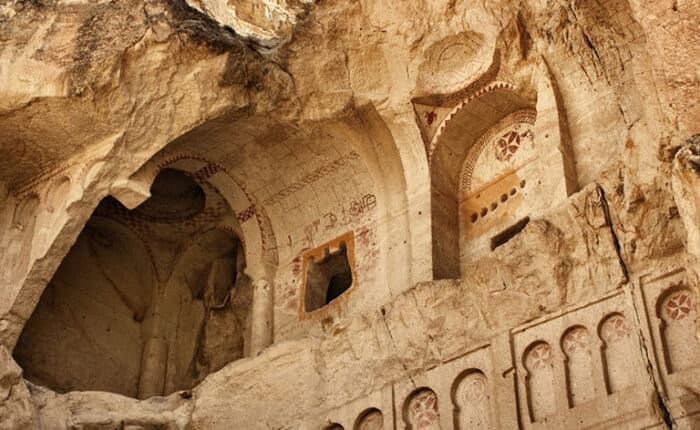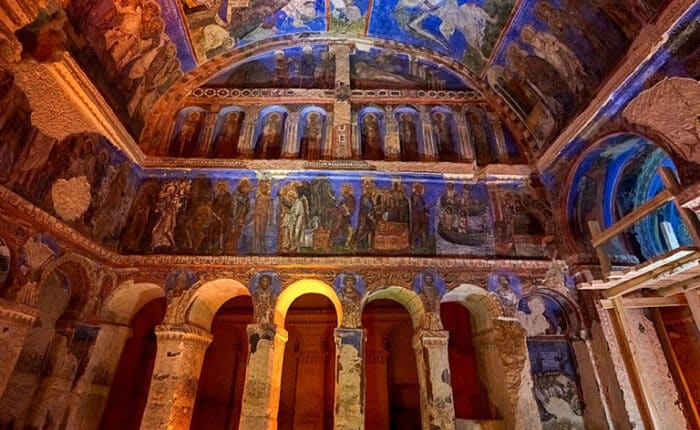During Roman times, the region of Cappadocia was used as a burial ground. As Christianity seeped into the Roman Empire, their burial grounds became more Christian in nature, including those in Goreme Valley. Therefore, some early saints were laid to rest in the valley, making it a sacred area to medieval Christians.
This sanctity, combined with the region’s desert-like topography, drew monks looking for ideal places to lead a contemplative life. The monks formed small monasteries, and over time, more monks and hermits joined them in Goreme Valley, turning the area into a pilgrimage destination. With this influx of pilgrims, the region’s holistic reputation grew, and thus, the need to construct chapels in the region.
Therefore, the numerous rock-cut churches in the region came to life. The churches were in use until the population exchange that was much later than the Ottoman occupation. Eventually, the Christian population in Anatolia decreased, and the significance of cave churches also faded over time. It was not until the mid-20th century that the valley regained its once irresistible only this time, it drew researchers and tourists who wanted to explore medieval monasteries.
Goreme Valley has a long history of interaction with Christianity, which predates some of the churches there. In the 4th century, Christian believers had a great desire to lead a monastic life free from the secular world’s pleasures and influences. Therefore, the great Saint Basil founded this way of life in Cappadocia.
During this time, Christians were still facing persecution for their beliefs and therefore needed a place to hide from the world. The Cappadocian region made an ideal hiding spot due to its moonscape topography and relatively inhospitable state that discouraged habitation by other people.
A few centuries later, in the Iconoclastic period, the region again proved to be an ideal hiding spot for persecuted Christians. In this secluded section of the world, they would lead humble lives of worship and devotion out of the reach of their persecutors.
To preserve the region’s significance to Christian history, the “Goreme National Park and the Rock Sites of Cappadocia” was declared a UNESCO World Heritage Site in 1985.
As with every other Byzantine-era church (except for the iconoclastic period), paintings played an essential part in worship. Therefore, when churches were cut next to the monasteries, the monks made an effort to decorate the churches with wall paintings called fresco-secco (or a secco).
Masters were commissioned to draw various paintings on the walls and roofs of the cave chapels.
At their best, these paintings were of incredible detail, which you can still see today. Most of these wall paintings depicted various stages of the life of Christ or some important happenings in Christian history.
When the churches fell out of use, the paintings were left at the mercy of malicious acts by locals, which is why some of them have their eyes gouged out. They were also exposed to the elements and thus, sustained some damage. Nonetheless, the paintings are still in pretty good condition, and visitors can enjoy the incredible detail that went into place.



To get to Goreme Open Air Museum, first head to Goreme town, which is only one mile away from the town center. There are plenty of signs that will send you in the right direction, and you can even walk to the open-air museum. For those driving, there is plenty of parking space near the museum’s entrance. Nonetheless, you can always book a tour with a professional tour company to avoid any inconveniences that may arise.
You will only be able to truly appreciate the otherworldly look of the terrain once you set foot in the museum. The monastery complex in itself looks like something out of an alien planet. After taking in the surreal landscape, you can now start exploring the museum. The ticket you purchased at the entrance gives access to all the open cave churches, except the dark church, which requires you to pay an additional 25TL to enjoy the well-preserved paintings.
Photography inside the cave churches is prohibited. But if you really love taking photos, the museum makes for an incredible background.
Opening Hours
From 1st April to 1st October, the museum is open every day between 08.00 and 19.00hrs.
From 1st October to 1st April, it is open between 08.00 and 17.00hrs.
In summer, the ticket counters close at 18.30, while in the winter, they close at 16.15.
The Goreme Open Air Museum is part of the larger Goreme Valley in Cappadocia. Here, there are numerous other cave churches that you can explore. On the other hand, the land of Cappadocia is full of attractions like Pasabag and Zelve fairy chimneys, underground cities, and hot air ballooning, which you should definitely try out.
If you want the best experience exploring Goreme Open Air Museum and Cappadocia as a whole, view our private day tours that cover this site and many other jewels.